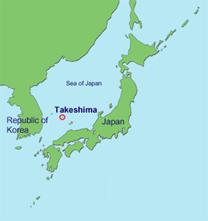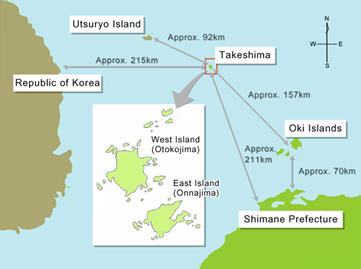| |
| |
TAKESHIMA Fact Sheet |
5 September 2012
Embassy of Japan in Ethiopia |
|
 |
Since the beginning of August 2012, a series of incidents have taken place in the waters surrounding Japan, which may endanger the sovereignty of the nation. This is extremely regrettable. Japan cannot overlook such conduct. Here is the position of the Japanese Government on Takeshima and the historical facts which attest to Japan’s sovereignty over the island.
|
| Recent developments |
 |
In light of the historical facts and based upon international law, Takeshima is an integral and inherent part of Japanese territory. A territorial dispute exists over Takeshima with the Republic of Korea (ROK), and recently President Lee illegally set foot on Takeshima. The position of Japan is that the two countries should settle the territorial dispute in a calm, fair and peaceful way based on international law, and Japan hopes that the ROK will sincerely respond to Japan’s proposal, made in good faith, of neighborly friendship.
|
 |
On August 21, Japan officially presented the ROK with a diplomatic proposal to institute proceedings before the International Court of Justice (ICJ) by a special agreement between the two countries on the dispute over the sovereignty of Takeshima. However, on August 30, the Government of the ROK replied via a note verbale that it did not accept the proposal.
|
 |
The ROK is an important member of the international community and supports the rule of law through its activities in the United Nations and other international organizations. In addition, the ROK has been positioning itself under the catch phrase of “Global Korea.” Therefore, Japan was hoping that the ROK would accept the proposal and sit at the ICJ to present its own case in a calm and fair manner. The reply from the ROK, which did not indicate any specific counter proposal to settle the Takeshima issue, was extremely disappointing. The fact that the ROK denied Japan’s proposal for a legal settlement indicates how unconfident the ROK is on its claim to the island.
|
 |
The best way to deal with an international dispute is, in light of “law and justice” of the international community, to file a case with the ICJ for settlement. The Government of Japan will continue to urge the ROK to settle this dispute based on international law.
|
| Historical Facts |
 |
Several historical documents confirm that Japan established its sovereignty over Takeshima by the mid 17th century at the latest. During the early period of the Edo era, Takeshima was being utilized by merchants of Yonago in Tottori-Han who were engaged in catching abalone and sea lions under license from the Shogunate <Attachment 2>. Thus, Japan had established its effective control over the island by the mid 17th century at the latest.
|
| Note |
 |
There is no evidence that Korea had control over Takeshima before the establishment of Japan’s territorial sovereignty. For example, the ROK claims that Usan Island, which is described in old Korean texts such as the “Sinjeung Dong Yeoji Seungnam (A Revised Edition of the Augmented Survey of the Geography of Korea: 1531),” was the Takeshima of today. However, in the map of “Sinjeung Dong Yeoji Seungnam (A Revised Edition of the Augmented Survey of the Geography of Korea)” <Attachment 1>, Usan Island is located west of Utsuryo Island whereas Takeshima is located east of Utsuryo Island. This clearly shows that Usan Island was not the Takeshima of today, and thereby the claim of the ROK is not justified.
|
 |
In January 1905, the Meiji Government in Japan made a Cabinet decision to incorporate Takeshima into Shimane Prefecture, reaffirming Japan’s intention to claim sovereignty over Takeshima.
|
| Note |
 |
The ROK tries to link the Takeshima issue with the issue of interpretation of history. However, it is not appropriate to discuss the Takeshima issue in that context. There is clear evidence of Japan utilizing Takeshima as a part of its territory throughout the Edo Era, as mentioned above. Therefore, this issue is based on facts.
|
 |
During the drafting of the San Francisco Peace Treaty in 1951, the ROK submitted to the US Government a request to include Takeshima among the territories Japan should renounce. The US Government declined this request, expressing its position that Takeshima was an integral part of Japan’s territory. This position is further verified by the fact that Takeshima was later designated as a bombing range for US Forces operations in Japan in 1952 by a bilateral agreement under the Japan-U.S. Security Treaty. This fact shows that the international community has recognized Takeshima as an integral part of Japan.
|
 |
However, in 1952, the ROK unilaterally proclaimed an artificial boundary encompassing Takeshima (which it called the “Syngman Rhee Line”)in clear contravention of international law. Since then, the ROK has been illegally occupying Takeshima. During the 13 years after the “Syngman Rhee Line” was installed and up until it was abolished by the conclusion of the Japan-ROK Fisheries Agreement, many Japanese fishing boats were seized and many Japanese fishermen were detained, causing heavy casualties including the death of Japanese citizens.
|
 |
Japan proposed to the ROK that the issue concerning the sovereignty of Takeshima be referred to the ICJ as early as 1954 and again in 1962. However, the ROK rejected those proposals.
|
| |
*Takeshima
|
| |
 |

|
 |
Takeshima is a group of islands that is situated in the Sea of Japan at a latitude of 37º 14'N and a longitude of 131º 52'E, 157 kilometers northwest of Oki Island, Shimane Prefecture. Takeshima is part of Okinoshima Town of Shimane Prefecture.
|
 |
The combined area of the two main islands, the East Island (Onnajima) and the West Island (Otokojima), and numerous small reefs is 0.21 square kilometers (about half the size of Rizal Park in Manila: 0.54 km2).
|
 |
Both are precipitous volcanic islands, and cliffs abut the coastline on all sides. The islands have scarce vegetation and few sources of drinking water.
|
 |
There is no clear-cut evidence that Korea recognized the existence of the islands, let alone had control over Takeshima before the establishment of Japan’s territorial sovereignty. For example, a 16th century document referred to by the ROK to justify their claim, locates the claimed island in a different geographical position from that of the Takeshima of today.
|
| |
|
| |
(For more details regarding facts and Japan’s position, please refer to the following web site: |
| |
http://www.mofa.go.jp/region/asia-paci/takeshima/ ) |
|
-End- |
| |


